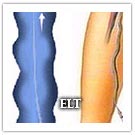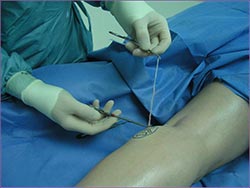Treatments
At Texas Vein and Vascular, we take pride in offering a full range of all scientifically tested, medically approved treatment options. Unlike most other vein-care centers, we are not limited to just one or two treatment options. Because we have all available tools in our toolbox, we feel that we are the best choice for your vein-care needs.
We also take pride in staying up-to-date with the latest developments in vein-care. Our physicians and nurses attend and participate in many scientific medical meetings each year, and are regular contributors to the medical literature.
We are passionately committed to providing you with the least invasive yet scientifically tested, medically approved treatment options for achieving long-term relief from your vein problems.
Some of the treatment options we offer at Texas Vein and Vascular include:
Microsclerotherapy
Microsclerotherapy is a technique which was developed in the 1950s and 60s to treat spider veins. It evolved out of doctor’s experience with Compression Sclerotherapy, with which is shares many similarities. It involves the use of an extremely fine needle to inject a tiny amount of a dilute solution (sclerosant) directly into the spider veins. The solution causes the lining of the vein to swell, eventually sealing off the blood vessels and preventing blood flow. At Texas Vein and Vascular, we use sodium tetradecyl as our sclerosant of choice because it is painless and effective.
Prior to treatment, a complete medical history is taken and a thorough examination made in order to determine, among other things, how long the problem has existed, are there any ongoing causative factors, and if there are any associated symptoms. Normally, an ultrasound study is not indicated, unless the spider veins are found in conjunction with larger varicose veins. If your spider veins are found in conjunction with varicose veins, and i the valves in your greater saphenous vein are broken, an Endovascular Laser Venous System may be recommended before Microsclerotherapy is undertaken. Pre-proceedure instructions may include the elimination of certain medications which are know to aggravate spider veins, and the elimination or minimization of any medications know to cause excessive bruising or bleeding.
If your spider veins are found in conjunction with varicose veins, then the larger varicose veins are usually treated first (but NOT by microsclerotherapy, which is only appropriate for spider veins). After the skin is thoroughly cleansed with alcohol, a small amount of sclerosing (hardening) solution is injected directly into the spider vein using a syringe with a very tiny needle. The vein immediately disappears, then returns in about 10-15 seconds and is actually MORE prominent than it was before treatment started. The irritated vein then fades away over a few weeks.

Microsclerotherapy Before and AfterThe solution displaces the blood within the vein, causing it to blanch or turn white. The solution then causes the vessel to become irritated and swell shut, prohibiting the blood from reentering the vein. The skin may be kneaded to help disperse the solution and reduce bruising. Each vein may require several injections and most disappear in a few weeks.
After your treatment, you are NOT wrapped in compression bandages, but we may put a simple small band-aid over the injection site to protect your clothing. You then simply walk out of the office and immediately resume normal daily activities.
The Benefits and Expected Results:
- Gets rid of unsightly spider veins
- Normalizes skin blood flow
- No incisions, so no scars
- Does not interfere with normal activities
- Safe, virtually painless, in-office treatment
- Walk-In to Walk-Out time is typically 30 minutes
Endovenous Laser and Radio Frequency

Endovenous Laser TherapyThe Closure procedure is a relatively new method used to treat varicose veins that are caused by broken valves in the Greater Saphenous Vein. Approximately 30% of patients with varicose veins have this situation. The traditional way to treat this situation is with a vein stripping. The Closure procedure has basically replaced the vein stripping procedure and has made vein stripping an antiquated procedure
The Closure procedure closes down and seals off the Greater Saphenous Vein, effectively removing it from your circulation without removing it from your body. The procedure is quick, minimally invasive, and leaves no scar. It has a short and relatively pain-free post-operative recovery period, and is performed under local anesthesia in the doctor’s office at the Texas Vein and Vascular. The treatment itself normally takes less than one hour.
Procedures
There are two basic types of procedures; one is called VNUS™ and the other is called ELVS or EVLT. The main difference between these two types of procedures is the type of energy that is used to heat the catheter tip.
All these procedures treat the Greater Saphenous Vein from the inside using a catheter with a heated tip. All procedures produce the same clinical results with no significant differences in the recovery time or potential for complications.
Although Dr. Alonso has been trained in both types of procedures, he prefers the VNUS Closure procedure because is causes less pain and bruising and the heat energy delivered to the vein wall is much more stable.
The basic steps in the ablation procedure (either by radiofrequency or laser) are as follows:
- The area of the leg to be treated is cleansed with a sterile disinfectant soap.
- An ultrasound study is done using a sterile ultrasound probe.
- A small area of skin is then anesthetized, usually just below the knee.
- Through this anesthetized skin, a needle is then inserted into the greater saphenous vein.
- Through the needle, a catheter is passed up into the greater saphenous vein to the top of your thigh.
- Once the catheter is in place, a larger area of your leg (from the calf to the top of your thigh) needs to be anesthetized with some more local anesthetic. This is the ONLY part of the procedure that is a little uncomfortable, because we have to give you a moderate amount of local anesthetic.
- The catheter is connected to its energy source, and the catheter is slowly withdrawn, delivering energy to the wall of the vein as the catheter is backed out of the vein.
- The catheter-delivered energy heats the vein wall, causing it to shrink and collapse.
- The vein then seals itself shut, preventing blood from pooling and lowering the pressure in the vein to zero.
- We put a band-aid on your leg, you put on your support stocking, and you walk out of the office with a healthier leg!
The Benefits and Expected Results
- A simple procedure
- Performed under local anesthetic in the Doctors Office
- Minimally invasive, minimal risk of scarring or postoperative infection
- Less than one hour treatment time
- Rapid recovery with reduced postoperative pain
- Normal activities can be resumed immediately
- Excellent clinical and cosmetic results
Ambulatory Phlebectomy

Ambulatory phlebectomy micro-extraction is a minor surgical procedure which allows for the removal of large surface varicosities through very small incisions that need no stitches. The procedure is normally done in the office at the Texas Vein and Vascular using a local anesthetic.
The procedure normally takes less than one hour. There is very little discomfort with the procedure and very little “down time” during your recovery. Most people who work can go back to work the day following the procedure, although many patients take the day off just to be sure they are fully recovered before returning to work.
After cleansing and anesthetizing the skin, minute skin incisions are made with an instrument that limits the size of the micro-incision to 1.5 mm. Another instrument is inserted under the surface of the skin to extract a length of the varicose vein through this micro-incision.
With this procedure, a compression bandage is worn for 5 to 7 days until you are seen in the doctor’s office for follow-up. After this, a support stocking is worn until all bruising resolves, usually in about one more week. The compression bandage and support stocking minimizes swelling and discomfort and allows for proper healing.
The basic steps in the Ambulatory Phlebectomy procedure are as follows:
- Some patients take a mild sedative about one hour before the procedure to help them relax. This is not required and only about half my patients opt for a sedative. I will give you a prescription for this mild sedative when we schedule the procedure.
- The areas to be treated are marked with an indelible marker while you are standing.
- You then lay down on an examination table and the area of the leg to be treated is cleansed with a sterile disinfectant soap.
- Sterile paper towels are then put in place to cover the non-sterile parts of your skin we don’t want to touch.
- A small area of skin is then anesthetized with a local anesthetic, right over one of your varicose veins.
- Through this anesthetized skin, a 1.5 mm micro-incision is made.
- Through the micro-incision, additional anesthetic is pumped into the tissue around the varicose vein. This helps to loosen the varicose vein and make its extraction easier. It also helps to anesthetize your deeper tissues so you remain comfortable during the procedure.
- Through the micro-incision fine surgical instruments are used to extract as great a length of the varicose vein as can be reached from the micro-incision. Normally, this is a length of about one inch in either direction, so about two inches of vein can be extracted through one micro-incision.
- Another small area of skin is anesthetized with a local anesthetic, usually about 2 inches from the first micro-incision, and steps # 6, 7 and 8 are repeated until the entire length of the varicose vein is removed.
- We put some butterfly tapes over your micro –incisions, we then wrap your leg in a comfortable but snug compression wrap, and you walk out of the office with a healthier leg!
The Benefits and Expected Results
- A very simple procedure
- Performed under local anesthetic in the Doctors Office
- Cost effective. It does not incur any charges from the hospital or an anesthesiologist
- Minimally invasive, so minimal risk of scarring or postoperative infection
- Less than one hour treatment time
- Rapid recovery with reduced postoperative pain
- Normal activities can be resumed immediately
- Excellent clinical and cosmetic results


